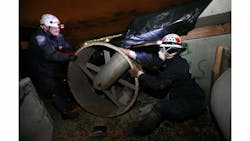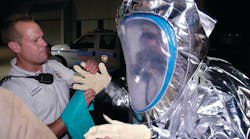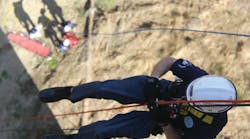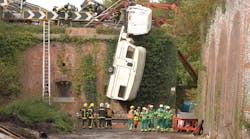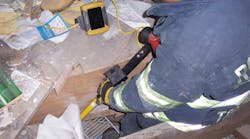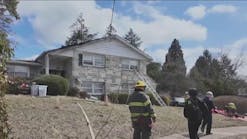When developing and reassesing your technical rescue team, you must understand resource typing and how it relates to your team. Before we get into the breakdown of the various resource typing tools available to the first responder, it is important to remember that the list is a guide, it does not imply that you should or should not have a specific resource or piece of equipment listed in the typing list.
Two examples of this are:
- A community used the guide to substantiate their desire to obtain a specific piece of equipment that falls in the “wanted, not needed” category. Although this particular item is on an equipment-typing list you must first do an operational and fiscal analysis of the true need for this or any of the items listed. With the days of overflowing grant funds coming to, or at, an end, you must be even more responsible in your expenditures so the limited funds still available provide the greatest value to your community.
- While sitting in a planning conference a few years ago, one agency’s representative, when asked for local needs, raised his hand and asked if anyone knew where he could obtain a specific tool related to shoring.
A bit of background on this particular tool; it was phased out of the USAR system a while back and is no longer a part of our operational system. When asked why he was looking for this particular piece of equipment his reply was, “It’s on the equipment resource typing list for structural collapse and I must have it to meet my typing goals.”
A few things came from this comment; first the realization that these lists are viewed by some as gospel – if it’s on the list I must have it. Second, the realization that these lists are not updated on a regular basis, you may be working off a document that is a number of years old. Always do your homework and obtain the most current versions of any document you are using.
FEMA defines resource typing as “the categorizing, by capability, the resources requested, deployed and used in incidents. Measurable standards identifying resource capabilities and performance levels serve as the basis for categories. Resource users at all levels use these standards to identify and inventory resources.”
Resources are broken down by:
- Discipline: (fire, law, etc.)
- Category: Function (firefighting, law, health, etc.)
- Kind: Measurements of capabilities/capacity (personnel, equipment, supplies)
- Type: Minimum capabilities
Federal & Local Resources Guides
FEMA has created 120 resource types that are divided amongst 16 national resource-typing categories. This is a large number of typed resource definitions. For this article, we will utilize the Search and Rescue Resources guide as it is directly associated to technical rescue operations.
While the federal resource guide is very detailed it does not cover all components of the technical rescue field. Rope, confined space and trench rescue are some of the activities not covered. Many states have developed resource-typing guides to cover these areas of technical rescue. It is best to check with your state representatives to find out what typing guides exist as your team develops.
These guides provide the minimum capabilities required to meet different typing levels. Most technical rescue operations have a minimum of two levels of typing, while a majority of the specialties have four levels. A Type 1 team is the highest level of capability and a Type 4 team has the least typing level within the system. Some areas such as Canine Search and Rescue have additional qualifications that fall into an “other” category. The specific resource is broken down into components with an associated metric for the team’s functions.
Components consist of: Personnel, Team, Equipment, Supply, Vehicle, Air Crew, Single Resource, Management Support and Transportation. These components are applied to the specific specialty as needed to create a functional capability that can be provided to those in need of assistance.
Team Capabilities
Within the minimum capabilities list for a team are metrics and they further break down how a team is measured in specific areas of their response grouping. For example, the Collapse Search and Rescue Teams guide divides the Team components into specific lines for:
- Training
- Sustained operations
- Safe and effective response Operations incidents
- Specialty search and rescue capabilities
- Certifications
Each of these five lines provides guidance for achieving specific typing levels within this resource group.
Some components will be more in depth than others. Occasionally a single component will carry over from one typing level to another. An example of this process is in the Medical Materials Equipment metric. To meet Type 4 standards you need to have Medical Aid Equipment, Backboards and Stokes Stretcher. This remains consistent through a Type 1 team, so the notation of “Same as Type 4” continues across the grid.
Most of the definitions will have a comment section at the end of the specific resource, which provides additional information related to that area of operations.
The equipment component of a resource category is broken down further by specialty. These equipment lists are created at the Federal and state levels depending on the specific specialty. Once again these lists can be every extensive with multiple sub-groups. In the case of a USAR teams typing lists, it is broken into personnel and eight equipment sub-groups. These sub-groups are also broken down further by item types within each group. For example, the Rescue Section Tools tab within the USAR teams’ equipment typing list is broken down into 10 additional groupings consisting of over 300 line items. Once you begin to drill down into the complexities of these typing categories you will find great value in becoming well versed in the navigation of this system.
In addition to the equipment tabs on these lists, there is traditionally a personnel tab. This section provides a breakdown of various team positions and specific staffing numbers required to meet the various typing levels. Training requirements may also be found in this section. Having the correct numbers of personnel to meet a requirement is one part of the puzzle, the other and more important part is having properly trained and/or certified personnel in these positions.
After this brief overview of the various resource typing tools available to a technical rescue team, your next goal is to become functionally familiar with their content.
So far we have focused on the format and content of resource typing. How does resource typing apply to your team when a call for assistance arises? During a disaster an emergency manager will utilize this typing information in their process of requesting capable resources. Their goal is to obtain resources that can respond to the incident and provide efficient and effective operations when needed. The typing definitions help with the ordering and mobilization of these resources.
FEMA sums this process up in their Definitions guide: “As a result of the resource typing process, a resource’s capability is readily defined and an emergency manager is able to efficiently request and receive resources though mutual aid during times of disaster”.
A few of the other resources available to help you with your team’s development and sustainment are (Note: all of these resources can be found at http://www.fema.gov/media-library/assets/documents/25574):
FEMA’s Responder Knowledge Base (RKB) - The RKBs mission statement: “Provide emergency responders, purchasers, and planners with a trusted, integrated, online source of information on products, standards, certifications, grants and other equipment-related information."
The Authorized Equipment List (AEL), published by the FEMA Grant Programs Directorate, Department of Homeland Security - The Standardized Equipment List (SEL), which is produced by the Inter Agency Board for Equipment Standardization and Interoperability (IAB), and contains minimum equipment recommendations for response to weapons of mass destruction (WMD) incidents. It also includes recommended features and operating considerations.
Conclusion
As you move forward, you must remember to remain focused on learning. This is important on the operational side of your team as well as keeping up with the changes that take place on the administrative side. Local, state and national training conferences are excellent places for this type of learning.
In New York, we held our first annual technical rescue leadership conference two years ago. This event brought leadership together from our largest organizations down to the smallest rural response teams to share information and to learn from one another. This program has since evolved into a statewide conference, which has combined leadership sessions, classroom programs and hands-on skill refreshers.
Once of the best quotes I continue to use from one of my mentors is, “A good team never meets in the huddle.” This statement provides great incite to the work we all do in the technical rescue community. Very few incidents of significance are handled by a single jurisdiction. When that “big event” hits your community there will be little time for feeling out your assisting resources ability to help you in your time of need. By talking, training and sharing experiences prior to that event you will all operate at a much higher level when the call for the “big event” comes in.
BOB DUEMMEL is the technical rescue editor for Firehouse Magazine and Firehouse.com. He is also the deputy coordinator for Special Operations in Monroe County, N.Y. and a captain with the City of Rochester Fire Department. He is the Plans Manager for New York Task Force-2 USAR Team, a member of the Western New York Incident Management Team and a member of the New York State Technical Rescue curriculum development team. He is a nationally certified instructor with a focus on technical rescue programs. He has delivered training to fire service, industrial, military and international rescue teams and has assisted with exercise evaluation for the United Kingdom and the European Union's USAR program. Bob has also participated in numerous USAR exercised as both a participant and evaluator. He is host of “The Buzz on Technical Rescue” podcast. Bob can be reached at [email protected].
